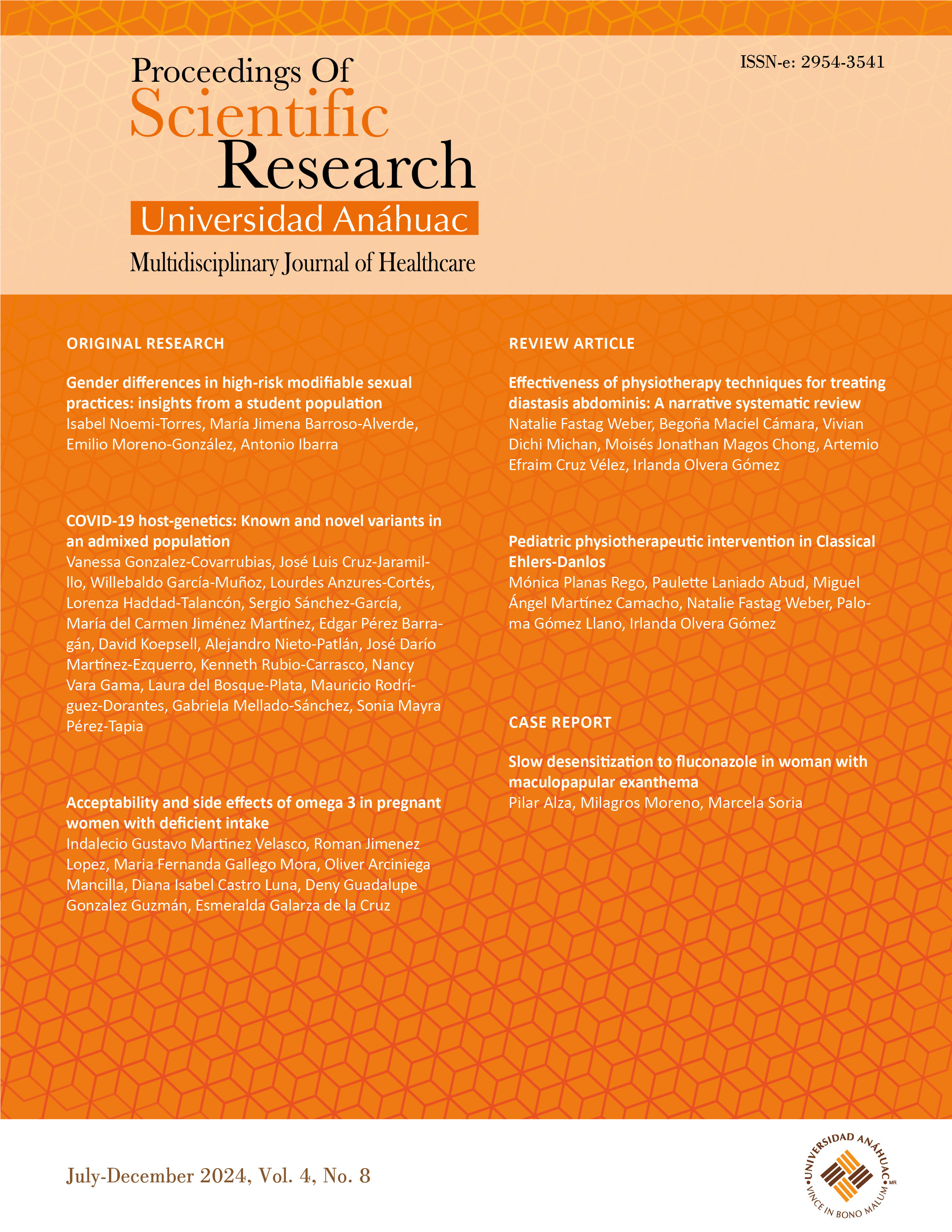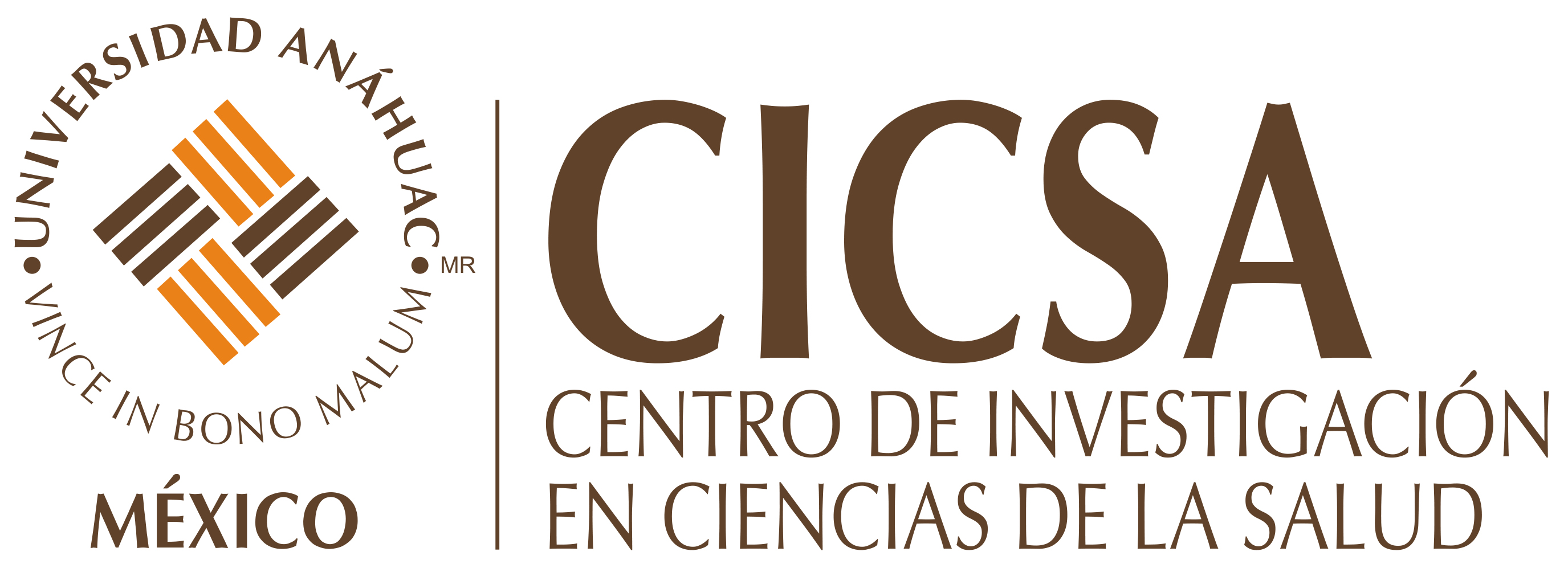COVID-19 host-genetics: Known and novel variants in an admixed population
DOI:
https://doi.org/10.36105/psrua.2024v4n8.02Palabras clave:
COVID-19, genética humana, variantes genéticas, población mestizaResumen
Introducción: Las variantes genéticas asociadas a la COVID-19 son indicadoras de genes causales y potenciales blancos terapéuticos. Desafortunadamente, la mayoría de estos estudios se han realizado en individuos de ancestría europea y desconocemos la presencia de éstas en otras poblaciones. Objetivo: Identificar y confirmar la frecuencia alélica de variantes relacionadas con la COVID-19 en población mexicana mestiza en los genes ABO, CCR2, CCR9, CXCR6, DPP9, FYCO1, IL10RB/IFNAR2, LZTFL1, OAS1, OAS2, OAS3, SLC6A20, TYK2, and XCR1. Métodos: El ADN de 106 pacientes y 2677 individuos sin infección previa y al momento de la entrevista fueron genotipados mediante microarreglo e imputación. Se determinó la frecuencia alélica y ésta se comparó entre pacientes versus la población general. Resultados: Se confirmaron diferencias en la frecuencia alélica para las variantes ya reportadas, ABO rs657152, DPP9 rs2109069, LZTFL1 rs11385942, OAS1 rs10774671, OAS1 rs2660, OAS2 rs1293767, y OAS3 rs1859330 p<0.03. También reportamos más de 100 variantes con diferencias en la frecuencia alélica entre pacientes y la población general (p-value <10-2), se determinó el impacto funcional in-silico de éstas identificando 4 variantes con un impacto alto en ABO, OAS1/2 and FYCO1. Conclusiones: Se confirman diferencias en la frecuencia alélica entre pacientes con COVID-19 y la población general en mestizos mexicanos, para genes previamente asociados con COVID-19, validando estudios previos, y fomentando el desarrollo de metaanálisis que validen y complementen la información genética relacionada con la infección y severidad a la COVID-19.
Descargas
Referencias
K Niemi ME, Karjalainen J, Liao RG, et al (2021) Mapping the human genetic architecture of COVID-19. Nat 2021 6007889 600:472–477. https://doi.org/10.1038/s41586-021-03767-x.
Callaway E (2021) The quest to find genes that drive severe COVID. Nature 595:346–348. https://doi.org/10.1038/s41586-021-03767-x
Cobat A, Zhang Q, COVID Human Genetic Effort, Abel L, Casanova J-L, Fellay J (2023) Human Genomics of COVID-19 Pneumonia: Contributions of Rare and Common Variants. Annu Rev Biomed data Sci. https://doi.org/10.1146/ANNUREV-BIODATASCI-020222-021705
Niemi MEK, Daly MJ, Ganna A (2022) The human genetic epidemiology of COVID-19. Nat Rev Genet 23:533. https://doi.org/10.1038/s41576-022-00478-5.
Ellinghaus D, Jostins L, Spain SL, et al (2016) Analysis of five chronic inflammatory diseases identifies 27 new associations and highlights disease-specific patterns at shared loci. Nat Genet 48:510–518. https://doi.org/10.1038/ng.3528.
Pairo-Castineira E, Clohisey S, Klaric L, et al (2020) Genetic mechanisms of critical illness in COVID-19. Nat 2020 5917848 591:92–98. https://doi.org/10.1038/s41586-020-03065-y.
Ji XS, Chen B, Ze B, Zhou WH (2022) Human genetic basis of severe or critical illness in COVID-19. Front Cell Infect Microbiol 12:1401. https://doi.org/10.3389/fcimb.2022.963239.
Semiz S (2021) SIT1 transporter as a potential novel target in treatment of COVID-19. Biomol Concepts 12:156–163. https://doi.org/10.1515/bmc-2021-0017.
Williamson EJ, Walker AJ, Bhaskaran K, et al (2020) Factors associated with COVID-19-related death using OpenSAFELY. Nat 2020 5847821 584:430–436. https://doi.org/10.1038/s41586-020-2521-4.
Sousa Neto AR de, Carvalho ARB de, Oliveira EMN de, Magalhães R de LB, Moura MEB, Freitas DRJ de (2021) Symptomatic manifestations of the disease caused by coronavirus (COVID-19) in adults: systematic review. Rev Gaúcha Enferm. https://doi.org/10.1590/1983-1447.2021.20200205
Havervall S, Falk AJ, Klingström J, et al (2022) SARS-CoV-2 induces a durable and antigen specific humoral immunity after asymptomatic to mild COVID-19 infection. PLoS One. https://doi.org/10.1371/JOURNAL.PONE.0262169
Asgari S, Pousaz LA (2021) Human genetic variants identified that affect COVID susceptibility and severity. Nature 600:390–391. https://doi.org/10.1038/d41586-021-01773-7.
Butler-Laporte G, Nakanishi T, Mooser V, et al (2021) Vitamin D and COVID-19 susceptibility and severity in the COVID-19 host genetics initiative: A Mendelian randomization study. PLoS Med. https://doi.org/10.1371/journal.pmed.1003605
Freuer D, Linseisen J, Meisinger C (2021) Impact of body composition on COVID-19 susceptibility and severity: A two-sample multivariable Mendelian randomization study. Metabolism. https://doi.org/10.1016/J.METABOL.2021.154732,
Leong A, Cole JB, Brenner LN, Meigs JB, Florez JC, Mercader JM (2021) Cardiometabolic risk factors for COVID-19 susceptibility and severity: A Mendelian randomization analysis. PLoS Med. https://doi.org/10.1371/JOURNAL.PMED.1003553
Wendt FR, De Lillo A, Pathak GA, De Angelis F, COVID-19 Host Genetics Initiative, Polimanti R (2021) Host Genetic Liability for Severe COVID-19 Associates with Alcohol Drinking Behavior and Diabetic Outcomes in Participants of European Descent. Front Genet 12:765247. https://doi.org/10.3389/fgene.2021.765247.
Santesmasses D, Castro JP, Zenin AA, Shindyapina A V, Gerashchenko M V, Zhang B, Kerepesi C, Yim SH, Fedichev PO, Gladyshev VN (2020) COVID-19 is an emergent disease of aging. medRxiv. https://doi.org/10.1101/2020.04.15.20060095
Zhu N, Zhang D, Wang W, et al (2020) A Novel Coronavirus from Patients with Pneumonia in China, 2019. N Engl J Med 382:727–733, https://doi.org/10.1056/NEJMOA2001017.
Global Facts. https://globalhealth5050.org/the-sex-gender-and-covid-19-project/
Takahashi T, Ellingson MK, Wong P, et al (2020) Sex differences in immune responses that underlie COVID-19 disease outcomes. Nat 2020 5887837 588:315–320, https://doi.org/10.1038/s41586-020-2700-3.
Li Y, Jerkic M, Slutsky AS, Zhang H (2020) Molecular mechanisms of sex bias differences in COVID-19 mortality. Crit Care. https://doi.org/10.1186/S13054-020-03118-8
Tsiambas E, Chrysovergis A, Papanikolaou V, et al (2020) Chromosome X riddle in SARS-CoV-2 (COVID-19) - related lung pathology. Pathol Oncol Res 26:1, https://doi.org/10.1007/S12253-020-00878-0.
Tümer M, Kiliçaslan B, Akinci SB (2021) The power of X-chromosome in COVID-19. Anesth Analg 1966–1966, https://avesis.hacettepe.edu.tr/yayin/56d0fdef-8fc3-419e-bb16-fbac5cc9b56c/the-power-of-x-chromosome-in-covid-19.
Mueller AL, Mcnamara MS, Sinclair DA (2020) Why does COVID-19 disproportionately affect older people? Aging (Albany NY) 12:9959, https://doi.org/10.18632/AGING.103344.
Nanovskaya T, Patrikeeva S, Zhan Y, Fokina V, Hankins GD V, Ahmed MS (2012) Transplacental transfer of vancomycin and telavancin. Am J Obstet Gynecol. https://doi.org/10.1016/j.ajog.2012.06.064
Daniloski Z, Jordan TX, Wessels HH, et al (2021) Identification of Required Host Factors for SARS-CoV-2 Infection in Human Cells. Cell 184:92-105.e16 https://doi.org/10.1016/j.cell.2020.10.030.
Dite GS, Murphy NM, Allman R (2021) An integrated clinical and genetic model for predicting risk of severe COVID-19: A population-based case–control study. PLoS One. https://doi.org/10.1371/JOURNAL.PONE.0247205
Dite GS, Murphy NM, Allman R (2021) Development and validation of a clinical and genetic model for predicting risk of severe COVID-19. Epidemiol Infect. https://doi.org/10.1101/2021.03.09.21253237
Huffman JE, Butler-Laporte G, Khan A, et al (2022) Multi-ancestry fine mapping implicates OAS1 splicing in risk of severe COVID-19. Nat Genet. https://doi.org/10.1038/S41588-021-00996-8
Gemmati D, Tisato V (2020) Genetic hypothesis and pharmacogenetics side of renin-angiotensin-system in COVID-19. Genes (Basel) 11:1–17, https://doi.org/10.3390/genes11091044
Aydillo T, Esther Babady N, Kamboj M (2020) Mining a GWAS of Severe Covid-19. https://doi.org/101056/NEJMc2025747 383:2588–2589
Shelton JF, Shastri AJ, Ye C, et al (2021) Trans-ancestry analysis reveals genetic and nongenetic associations with COVID-19 susceptibility and severity. Nat Genet 2021 536 53:801–808, https://doi.org/10.1038/s41588-021-00854-7
Liu EY, Li M, Wang W, Li Y (2013) MaCH-admix: genotype imputation for admixed populations. Genet Epidemiol 37:25–37, https://doi.org/10.1002/gepi.21690
Uffelmann E, Huang QQ, Munung NS, de Vries J, Okada Y, Martin AR, Martin HC, Lappalainen T, Posthuma D (2021) Genome-wide association studies. Nat Rev Methods Prim 2021 11 1:1–21, https://doi.org/10.1038/s43586-021-00056-9
Clarke GM, Anderson CA, Pettersson FH, Cardon LR, Morris AP, Zondervan KT (2011) Basic statistical analysis in genetic case-control studies. Nat Protoc 6:121–133, https://doi.org/10.1038/nprot.2010.182
Purcell S, Neale B, Todd-Brown K, et al (2007) PLINK: a tool set for whole-genome association and population-based linkage analyses. Am J Hum Genet 81:559–575, https://doi.org/10.1086/519795
Alexander DH, Lange K (2011) Enhancements to the ADMIXTURE algorithm for individual ancestry estimation. BMC Bioinformatics 12:1–6, https://doi.org/10.1186/1471-2105-12-246
Bryc K, Velez C, Karafet T, Moreno-Estrada A, Reynolds A, Auton A, Hammer M, Bustamante CD, Ostrer H (2010) Genome-wide patterns of population structure and admixture among Hispanic/Latino populations. PNAS 107:8954–8961, https://doi.org/10.1186/1471-2105-12-246
Gonzalez-Covarrubias V, Morales-Franco M, Cruz-Correa OF, et al (2019) Variation in actionable pharmacogenetic markers in natives and mestizos from Mexico. Front Pharmacol 10:1169, https://doi.org/10.3389/fphar.2019.01169
Team RC (2014) A Language and Environment for Statistical Computing, http://www.R-project.org.
Butler JM, Hall N, Narendran N, Yang YC, Paraoan L (2017) Identification of candidate protective variants for common diseases and evaluation of their protective potential. BMC Genomics 18:575, https://doi.org/10.1186/s12864-017-3964-3
McLaren W, Gil L, Hunt SE, Riat HS, Ritchie GRS, Thormann A, Flicek P, Cunningham F (2016) The Ensembl Variant Effect Predictor. Genome Biol 17:122, https://doi.org/10.1186/s12864-017-3964-3
Roberts GHL, Partha R, Rhead B, et al (2022) Expanded COVID-19 phenotype definitions reveal distinct patterns of genetic association and protective effects. Nat Genet 54:374–381 https://doi.org/10.1038/s41588-022-01042-x
Institutional Repository for Information Sharing IRIS-PAHO, WHO. https://iris.paho.org/handle/10665.2/30324.
Yildirim Z, Sahin OS, Yazar S, Bozok Cetintas V (2021) Genetic and epigenetic factors associated with increased severity of Covid-19. Cell Biol Int 45:1158–1174, https://doi.org/10.1002/cbin.11572
Deleers M, Breiman A, Daubie V, et al (2020) Covid-19 and blood groups: ABO antibody levels may also matter. Int J Infect Dis. https://doi.org/10.1016/j.ijid.2020.12.025, https://doi.org/10.1002/cbin.11572
Solmaz İ, Araç S (2020) ABO blood groups in COVID-19 patients; Cross-sectional study. Int J Clin Pract. https://doi.org/10.1111/ijcp.13927, https://doi.org/10.1111/ijcp.13927
Rinninella E, Raoul P, Cintoni M, Franceschi F, Miggiano GAD, Gasbarrini A, Mele MC (2019) What is the healthy gut microbiota composition? A changing ecosystem across age, environment, diet, and diseases. Microorganisms. https://doi.org/10.3390/MICROORGANISMS7010014
Zeberg H, Pääbo S (2020) The major genetic risk factor for severe COVID-19 is inherited from Neanderthals. Nat 2020 5877835 587:610–612, https://doi.org/10.1038/s41421-022-00488-x
Shen Y, Wang J, Li Y, Zhang Y, Tian R, Yan R (2022) Structures of ACE2–SIT1 recognized by Omicron variants of SARS-CoV-2. Cell Discov 2022 81 8:1–4, https://doi.org/10.1038/s41421-022-00488-x
Matuozzo D, Talouarn E, Marchal A, et al (2023) Rare predicted loss-of-function variants of type I IFN immunity genes are associated with life-threatening COVID-19. Genome Med 15:22, https://doi.org/10.1186/s13073-023-01173-8
Pojero F, Candore G, Caruso C, Di Bona D, Groneberg DA, Ligotti ME, Accardi G, Aiello A (2021) The Role of Immunogenetics in COVID-19. Int J Mol Sci 2021, Vol 22, Page 2636 22:2636, https://doi.org/10.3390/ijms22052636
Rescenko R, Peculis R, Briviba M, et al (2021) Replication of LZTFL1 Gene Region as a Susceptibility Locus for COVID-19 in Latvian Population. Virol Sin 36:1241–1244, https://doi.org/10.1007/s12250-021-00448-x
Alkafaas SS, Abdallah AM, Hassan MH, et al (2024) Molecular docking as a tool for the discovery of novel insight about the role of acid sphingomyelinase inhibitors in SARS- CoV-2 infectivity. BMC Public Health 24:395, https://doi.org/10.1186/s12889-024-17747-z
Minnai F, Biscarini F, Esposito M, et al (2024) A genome-wide association study for survival from a multi-centre European study identified variants associated with COVID-19 risk of death. Sci Rep 14:3000, https://doi.org/10.1038/s41598-024-53310-x

Descargas
Publicado
Número
Sección
Licencia
Derechos de autor 2024 Vanessa Gonzalez-Covarrubiasa, José Luis Cruz-Jaramilllo, Willebaldo García‐Muñoz, Lourdes Anzures-Cortés, Lorenza Haddad-Talancón, Sergio Sánchez-García, María del Carmen Jiménez Martínez, Edgar Pérez Barragáne, David Koepsell, Alejandro Nieto-Patlán, José Darío Martínez-Ezquerro, Kenneth Rubio-Carrascoa, Nancy Vara Gama, Laura del Bosque-Plata, Mauricio Rodríguez-Dorantes, Gabriela Mellado-Sánchez, Sonia Mayra Pérez-Tapia

Esta obra está bajo una licencia internacional Creative Commons Atribución-NoComercial-SinDerivadas 4.0.
Todo el contenido intelectual que se encuentra en la presente publicación periódica se licencia al público consumidor bajo la figura de Creative Commons©, salvo que el autor de dicho contenido hubiere pactado en contrario o limitado dicha facultad a “Proceedings of Scientific Research Universidad Anáhuac. Multidisciplinary Journal of Healthcare©” o “Universidad Anáhuac México©” por escrito y expresamente.
Proceedings of Scientific Research Universidad Anáhuac. Multidisciplinary Journal of Healthcare se distribuye bajo una Licencia Creative Commons Reconocimiento-No comercial-Sin derivados 4.0 Internacional (CC BY-NC-ND 4.0).
El autor conserva los derechos patrimoniales sin restricciones y garantiza a la revista el derecho de ser la primera publicación del trabajo. El autor es libre de publicar en cualquier otro medio su artículo, como un repositorio institucional.














